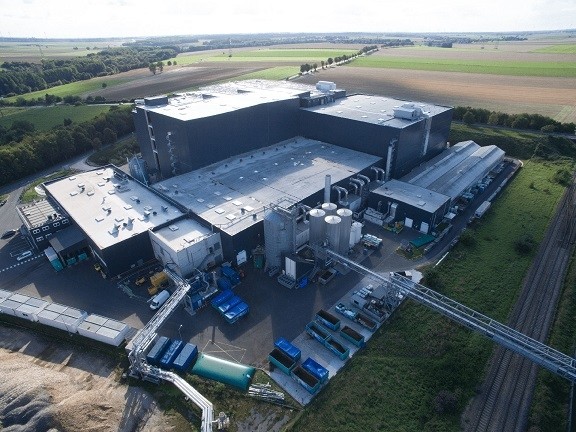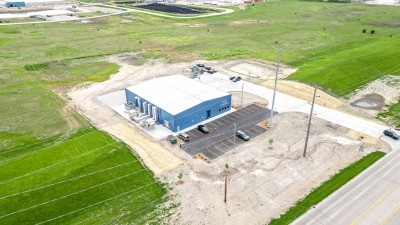Industrial symbiosis: a blueprint for green insect protein production?

A year after obtaining B Corp status, last week French insect protein producer Innovafeed published its first ‘Impact Report’, outlining its sustainability commitments and strategies.
The report provided some useful insight for feed users and producers who may be considering incorporating insect protein into their formulations, in terms of the potential for carbon savings by switching to these ingredients.
In the report, Innovafeed stated that its absolute carbon target is to keep its carbon footprint below 30,000 metric tons of CO2 per year by 2030, once its French site has reached its ramped-up annual capacity of 100,000 metric tons. At a product level, this goal will equate to 600kg of CO2 per ton of Hilucia protein meal, and 250kg of CO2 per ton of Hilucia oil.
Comparisons with conventional feed ingredients
For users and producers of feed, these figures are more meaningful when comparisons are drawn with conventional feed ingredients.
For example, when compared to conventional sources of oil as monogastric animal feed ingredients, substitution with Innovafeed’s insect oil will emit 93% less CO2 than soy oil, 92% less than copra oil, 90% less than rapeseed oil, and 14% less than palm kernel oil, according to the company.
In aquafeed, using insect meal as a fishmeal replacement will emit 87% less CO2 than soy protein concentrate, 84% less than soybean meal, 75% less than blue whiting from Norway, and 42% less than Peruvian anchovy. All things equal, Innovafeed said inclusion of 10% Innovafeed insect meal in fish feed formulation implies a reduction of 37kg CO2 equivalent per metric ton of formulated product.
“The savings of emissions from the use of Innovafeed insect protein, oil and fertilizer within the value chain will be tracked as ‘avoided emissions’ that result from our activity and help drive our suppliers and customers towards net zero emissions,” Maye Walraven, North American general manager and chief impact officer at Innovafeed, told FeedNavigator.
Location, location, location
As the company scales its operation and pursues its goal of building a low carbon, circular and zero-waste agri-food chain, industrial symbiosis will be a key strategy for reducing carbon emissions.
Industrial symbiosis is a production model that co-locates agro-industrial plants to generate cost and environment synergies. The company says this approach has allowed it to achieve closed loop circularity and reduce its carbon emissions versus other insect production models.
“Innovafeed’s insect production model distinguishes itself through its unique, innovative, and sustainable ‘industrial symbiosis’ approach, resulting in 80% lower carbon emissions,” said Walraven.
She said this approach is exemplified at the company’s Nesle site in northern France, where Innovafeed’s black solder fly vertical farm has established industrial synergies with the neighboring Tereos starch plant and Kogeban energy plant.
“Through the collaboration with Tereos, we recover co-products from the starch production process, promoting the efficient utilization of agricultural by-products and organic waste as valuable feed inputs for our insect production. This avoids 12,000 truck journeys per year by eliminating the drying phase for co-products recovered directly by pipeline. This not only minimizes waste but also reduces the need for additional raw materials, contributing to the circular economy,” explained Walraven.
With regard to Innovafeed’s colocation with Kogeban’s energy plant, Walraven said the insect production facility was able to leverage excess heat from the biomass power plant as an energy source for its insect production facilities by capturing heat via a hydro-condenser on a turbine.
“This partnership enables us to utilize sustainable energy, significantly reducing our carbon footprint and making our production process more environmentally friendly,” she said.
Innovafeed is planning to replicate this approach at other locations. Its next model will be in Decatur, Illinois, in the US next to its strategic partner Archer Daniels Midland (ADM).
Biomass access key to improvement
Whilst industrial symbiosis is enabling Innovafeed to harness the potential of insect production as an efficient, circular and zero waste opportunity to produce feed ingredients, the company recognizes that access to low value biomass availability is still holding the wider industry back.
It is a challenge that Walraven hopes will be addressed through regulatory changes.
“Insects have the natural ability to upcycle low value biomass, such as agricultural by-products ad organic waste, reducing reliance on conventional natural resources. Over time, we hope that regulation can evolve so that more sources of low value biomass can become available to recycle,” she said.
She added: To further enhance its sustainability, the industry should focus on optimizing feed conversion ratios and adopting environmentally friendly technologies in production processes.”









